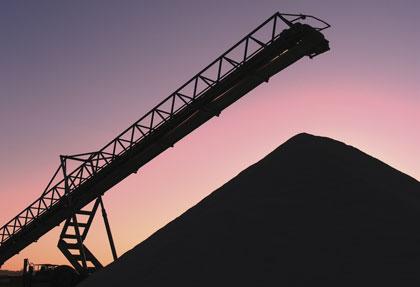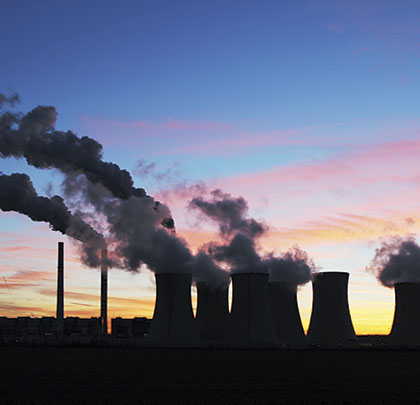Coal continues to play a significant role in the U.S. electric power industry. The American Coal Foundation reports that nine of every 10 tons of domestically mined coal is used to generate electricity. And more than half of the electric power consumed in the U.S. comes from coal-fired plants.
For these facilities, coal poses wastewater removal challenges, due to coal’s natural properties:
- Coal fines and dust can cause explosions under certain concentrations and conditions. So, coalfired power plants use water sprinklers to spray coal piles and suppress the dust. This improves air quality and reduces the explosion risk.
- Coal and coal dust are abrasive and corrosive. Spraying piles of coal with water—to suppress the coal fines to control explosion risk and improve air quality—creates a heavy acidic and abrasive slurry of coal fines, dust, and suspended coal fragments. The same happens when rain falls on and percolates through coal piles. Coal’s abrasive, caustic properties over time wear down and eat away at coal-handling equipment. And the inner workings of pumps that remove the coal slurry undergo the same stresses—particularly in standard submersible dewatering pumps.
This describes the experience and challenge of a 1,900-megawatt power plant, one of several power generation facilities, owned by a major Midwest power company.
THE CHALLENGE
The power plant had been using a variety of submersible solids-handling non-clog pumps, including rental units, to remove runoff from coal piled outside the plant after being delivered by rail. These pumps also removed runoff from a conveyor that moves coal into the plant, where it is pulverized before being combusted in furnaces to form steam that drives turbines and generates electric power.
The slurry from the coal piles and conveyor includes coal fines, dust, and fragments up to an inch in diameter. The pumps lacked the means to agitate the solids and disperse them in the water, so they settled and clogged the pumps.
And the abrasive, corrosive slurry quickly wore out and broke down the pumps’ internal components. This required frequent repairs and replacement of the pumps about every six months.

THE SOLUTION
The power plant’s pump maintenance and replacement costs added up over time, and the pumps’ maintenance demands took time from the in-house maintenance staff’s other priorities. Plus, the poorly performing pumps got in the way of efforts to maintain peak operational efficiency and a safe work environment.
Plant management identified a two-part solution to these challenges:
- Replace the facility’s current pumps with submersible units equipped with explosion-proof motors and internal components—volutes, impellers, and mechanical seals—made of robust materials that resist the abrasiveness and corrosiveness of coal slurry. They also would need to be equipped with agitators to decrease the risk of clogging.
- Improve capture of runoff from the coal piles and conveyors, to minimize random puddling of slurry on the grounds.
To address the first part of the solution, the power plant put out a call for pumps designed to prevent coal dust explosions and stand up to coal slurry. In the summer of 2015, Tramco Pump Company, a distributor for BJM Pumps® LLC, presented the power plant a recommendation: BJM’s XP-KZN explosion proof submersible slurry pumps that are equipped with an agitator.
The power plant also reviewed options from BJM competitors. Among these: a proposal from a company that could fill the power plant’s specifications. Except, the manufacturer would have to special order submersible agitator pumps and install explosion-proof motors in them. This would require a ten- to twelve-week lead time.
BJM XP-KZN pumps, on the other hand, are ready-made. Straight from BJM’s standard product offerings, they feature an explosion-proof motor, agitator and internal components made to resist coal slurry.
And, because of XP-KZN pumps’ ready availability, Tramco Pump Company was able to have them ordered and delivered in time for the October 2015 commissioning of two new 10-foot deep sumps the plant installed to collect runoff from the coal piles and conveyor. (A third sump was also installed, but has not yet been put into service.)
“The quick turnaround played in BJM’s favor,” a Tramco representative says. But the power plant cited other advantages, as well, when choosing to order:
- Four XP-KZN 37 pumps for the two new sumps. Two pumps for each sump—one as primary and the other as backup.
- Four pump seal minder relays. The pumps are located in a remote area of the power plant, so the relay are designed to send warnings to control boxes in the plant to indicate when a motor seal develops a leak, which would put the motor at risk of damage and failure.

Here are other features and benefits of BJM XP-KZN pumps noted by the power plant:
- Agitator. The XP-KZN’s integrated agitator provides maximum solids handling capability. The high-chrome agitator resists abrasion and corrosion as it fluidizes settled solids into a slurry. By keeping solids suspended in the liquid, the agitator allows the slurry and wastewater to be pumped away without clogging the pump. Corrosion resistance and explosion proof design in one pump. Few pumps offer this capability, which makes the XP-KZN the ideal solution for destructive liquids like coal slurry. While most dewatering pumps are made of cast iron, which wears quickly when exposed to abrasive slurries, the XP-KZN features a high chrome semi-open impeller, a hardened ductile iron volute, a high chrome wear plate, and a high chrome agitator. This reduces wear, breakdowns, and maintenance costs. And the spark-free electric pump motor design eliminates a potential source of ignition, promoting facility safety.
- Built-in lifting rings. These make lifting and lowering the pumps easy.
- A broad base. The large footprint base enables XP-KZN pumps to sit stably at the bottom of the sump, preventing tip-overs.

THE OUTCOME
Now, more than twelve months after the sale, the power plant is satisfied with the performance of the XPKZN pumps. They have already lasted more than twice as long as the pumps they replaced, and continue to deliver reliable service with less frequent maintenance.
The pumps’ agitators have prevented coal fines from building up around the pump intake, enabling the coal slurry to freely pass through the pumps without clogging. “The XP-KZN pumps have greatly reduced downtime, from the time it took them to diagnose pump breakdowns to the time to repair the pumps and return them to the sump,” the Tramco representative says. “This could take as much as three to four weeks when parts were not readily available.”
Based in Chicago, Tramco Pump Company was founded in 1924. In addition to distributing fluid handling equipment, Tramco specializes in designing, engineering and manufacturing pumps and custom pumping systems for industrial, commercial, residential, and O.E.M. markets.
For more information
visit www.tramcopump.com.
BJM Pumps®, headquartered in Old Saybrook, Connecticut, has been providing fluid handling solutions for industrial and municipal services since 1983. Over its thirty-year history, BJM Pumps has grown quickly by supplying world-class pumps and accessories, priced competitively, through its global network of stocking distributors. For more information, visit www.bjmpumps.com.
____________________________________________
MODERN PUMPING TODAY, July 2017
Did you enjoy this article?
Subscribe to the FREE Digital Edition of Modern Pumping Today Magazine!



